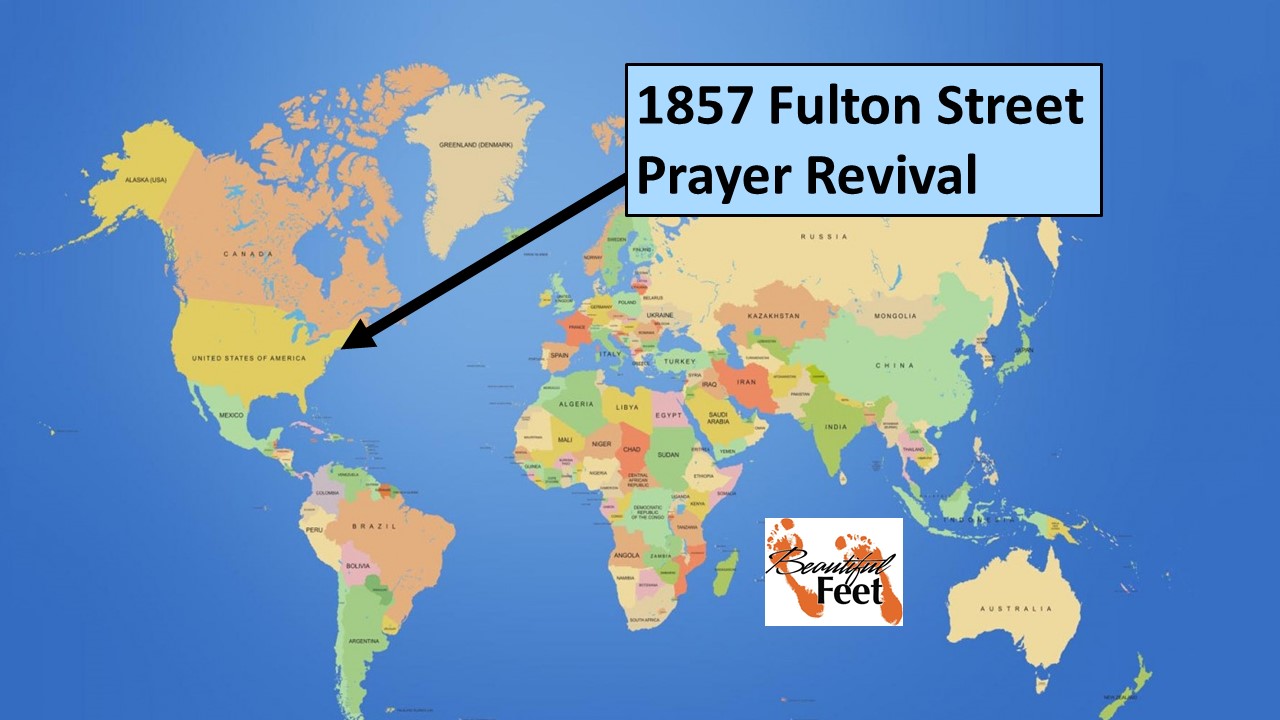

Many Names Given to this Revival
- The Great Awakening of 1857-1858
- Fulton Street Revival
- Laymen’s Prayer Revival
- Businessmen’s Prayer revival
- The Businessmen’s Revival
- 1857 Prayer Revival
- The Revival of 1857-1858
- The Awakening of 1857-1858
- Union Prayer Meeting
- The Third Great Awakening
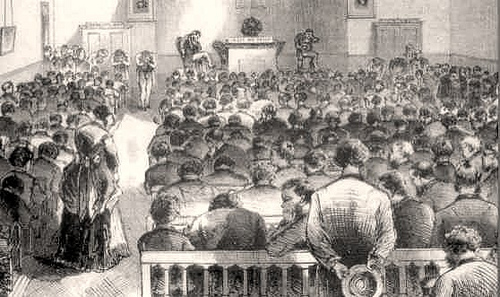
Typical Prayer Meeting of that Era
Condition of the Nation Prior to the Revival
(1845-1857)
From 1845 until 1857 the religious life in the United States was in decline and the momentum of the Second Great Awakening had faded away. These are some elements that led to this decline:
►A Baptist preacher (William Miller) had obtained a national following through his predicted date of the Lord’s return between 21 March, 1843, and 21 March, 1844. Some say the number of his followers (Millerites) reached 500,000. His influence led people to sell their property and give their wealth to the poor. When the predicted date passed but the return of Jesus didn’t happen, Miller set a second date of 22 October, 1844. When that date passed and nothing transpired, overwhelming disillusionment caused thousands to abandon Christianity, and become bitter unbelievers and even atheists. This event has since been labeled as The Great Disappointment.
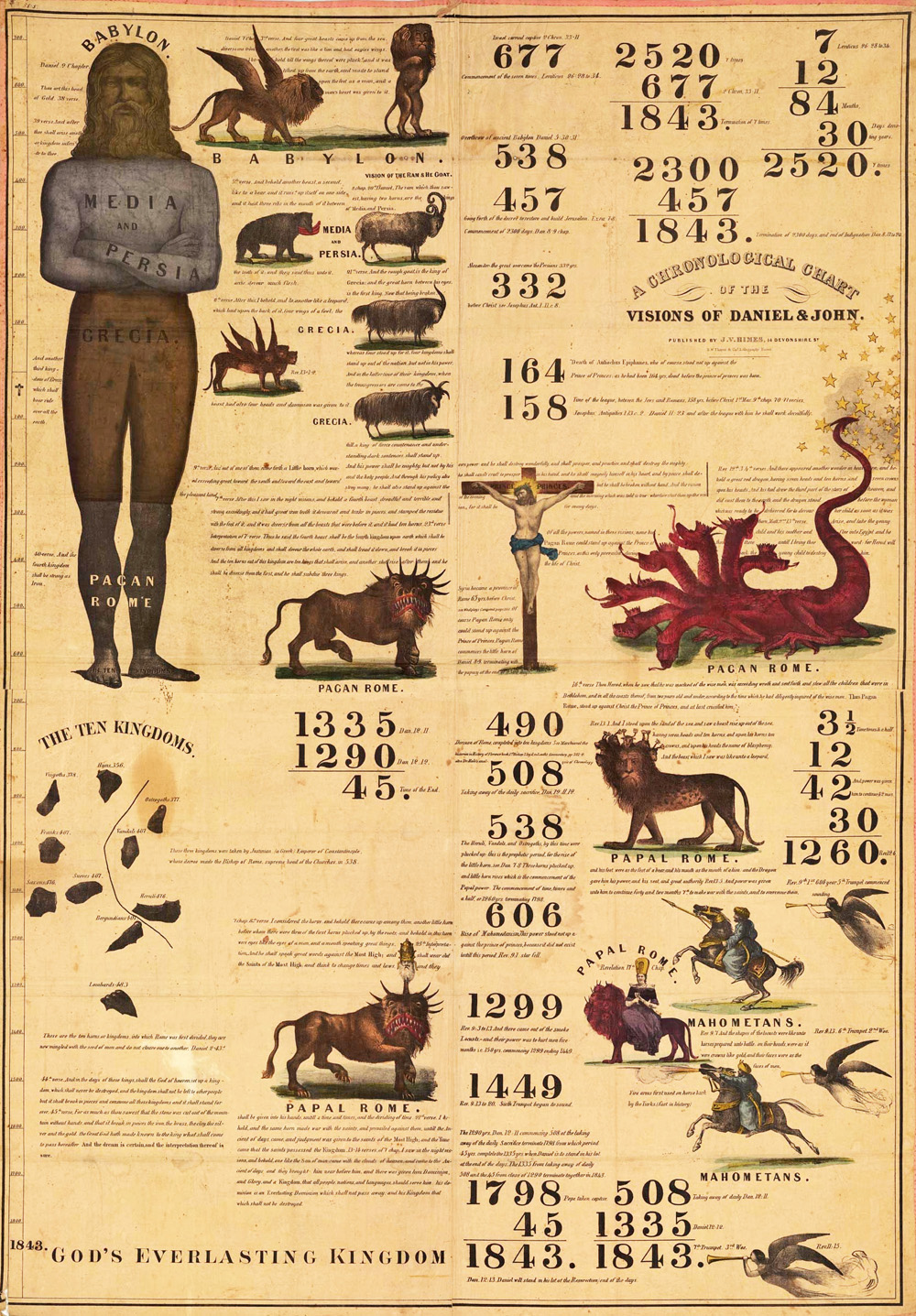 William Miller’s chart predicting the return of Jesus Christ.
William Miller’s chart predicting the return of Jesus Christ.
~~~~~~
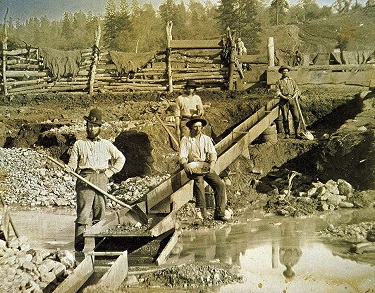
California Gold Rush
►Deep division in the nation, even among churches, over the slavery issue.
►A financial boom was taking place in the nation, turning people’s hearts toward the god of money.
• Large areas of land from the Mexican war had been acquired, and settlers were moving west in anticipation of great personal wealth.
•Railroads were expanded–railway mileage quadrupled in a few years.
•There was the discovery of gold in California.
•The industrialization of the nation was in full swing.
•Cities and states were rapidly being established.
•Telegraph lines were being run.
•Steamships were carrying produce and materials rapidly.
•Harvests were plenteous.
Extraordinary Prayer
To address the decline in the spiritual atmosphere, prayer-meetings were always the first thing that was initiated.
Prayer in Hamilton, Ontario
 ►Prayer for an “Outpouring of the Holy Spirit” took place on Thursday, October 9, 1857, in Hamilton, Ontario.
►Prayer for an “Outpouring of the Holy Spirit” took place on Thursday, October 9, 1857, in Hamilton, Ontario.
►That prayer meeting led to a 1,000 percent increase in membership at the participating churches in that city.
►Revival historian J. Edwin Orr indicated that the 1857 Hamilton, Ontario Revival “was the first unusual stream of blessing” that took place in 1857.
Prayer in Charleston, South Carolina
In the summer of 1857 an 8-week revival took place in the Charleston area. It is known as the 1857 Anson Street Revival. Some have suggested that this revival was instrumental in sparking the global awakening of that year.
Prayer in Pittsburgh, Pennsylvania
►On December 1, 1857, ministers from the Pittsburgh region, with some from as far away as Ohio, gathered to conduct a convention for three days. The purpose:
- Discuss the necessity for a revival
- Discuss how a revival’s blessing can be obtained
- Give encouragement to believe for a revival
- Discuss hindrances to revival
- Point out evidence of divine providence
- Pray for revival
►Two hundred ministers attended this meeting, in addition to many others. The result was that ministers delivered messages on the first Sunday of the new year 1858 on the subject of revival, and the first Thursday of the new year was held as a day of “humiliation, fasting, and prayer.”
Prayer in Cincinnati, Ohio
►Shortly after Pittsburgh’s 3-day convention, Cincinnati also conducted one for the same purpose.
►The anticipation and expectation for revival was being felt almost everywhere, and not long afterwards the revival fell upon Cincinnati and spread to the West.
Prayer in New York, New York
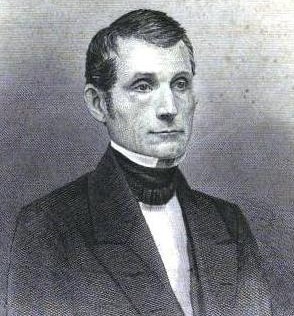
Jeremiah Lanphier
►The 48-year-old Jeremiah Lanphier accepted a position as a city missionary in downtown New York on July 1, 1857. He was working on behalf of the North Church of the Dutch Reformed faith on Fulton Street (Manhattan). This church was suffering a decline in membership, along with most of the other churches in the city and nation.
►Lanphier’s work began by organizing a Wednesday noonday prayer-meeting. He spent some time handing out leaflets informing people of the location and time of the prayer-meeting.
Week One: At noon, September 23, 1857, Lanphier began the prayer-meeting…, alone. After about 30 minutes several people began to trickle in, and a total of six people joined him in prayer on that day.
Week Two: On September 30, 1857, 20 people were present at the prayer-meeting. During this time the great financial panic reached a crisis and crippled businesses everywhere.
Week Three: On October 7, 1857, 40 people were present, and those assembled decided to begin meeting daily for prayer. During this same week, the Revival of Hamilton, Ontario began (mentioned above).
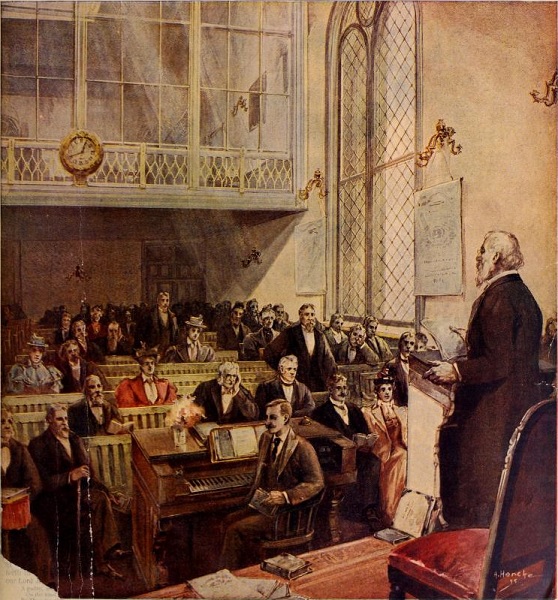 Fulton Street Prayer Meeting
Fulton Street Prayer Meeting
What Developed
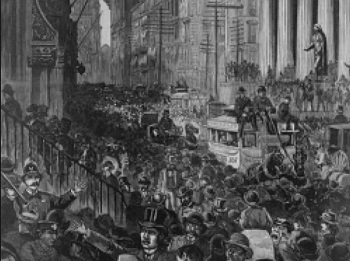
Fulton Street, NY | 1857 Revival
►By November 1857 the Fulton Street Prayer Meeting began holding three simultaneous prayer meetings in different rooms. There was no preaching, just praying.
►Prayer meetings were being conducted in cities and towns throughout the United States. Unsaved people would attend the prayer meetings and leave converted.
►At the beginning of 1858 reports of revivals began to appear in the religious press.
►The Gothic Church in Brooklyn reported 75 conversions in a local revival in January 1858.
►Yonkers experienced revival and nearly 90 people were converted.
►New Jersey was also experiencing similar revival blessings.
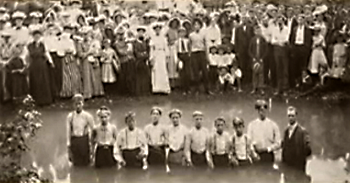
Water Baptism | 1857 Revival
►By February 1858 the deluge had started. The secular press began giving space to report on the revival.
►Other churches and theaters began opening their doors for noonday prayer to accommodate the crowds wanting to pray.
►Churches began conducting evening services in addition to the noonday prayer, and souls were being saved daily.
►“Revival News” was the talk of the nation, with secular newspapers being a key tool the Lord used to spread the revival. This is a March 20, 1858, editorial from the New York Times:
The great wave of religious excitement which is now sweeping over this nation, is one of the most remarkable movements since the reformation…. Travelers relate that in cars and steamboats, in banks and markets, everywhere through the interior, this matter is an absorbing topic. Churches are crowded; bank-directors’ rooms become oratories; school-houses are turned into chapels; converts are numbered by the scores of thousands. In this City, we have beheld a sight which not the most enthusiastic fanatic for church-observances could ever have hoped to look upon; we have seen in a business-quarter of the City, in the busiest hours, assemblies of merchants, clerks and working-men, to the number of 5,000, gathered day after day for a simple and solemn worship. Similar assemblies we find in other portions of the City; a theatre is turned into a chapel; churches of all sects are open and crowded by day and night…. It is most impressive to think that over this great land tens and fifties of thousands of men and women are putting themselves at this time in a simple, serious way, the greatest question that can ever come before the human mind ‘What shall we do to be saved from sin?’
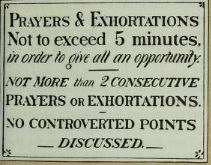
Rules at the Fulton Street
Prayer Meetings of 1857
►The same scenes were soon reported from all over the nation, from New York to California, Florida to Maine. It affected judges and college students, businessmen and housewives. At times, schools had to close in order to pray and seek God.
►Every city, village, school, and college was impacted.
►By April 1858, 10,000 businessmen were gathering daily for prayer in New York.
►By May 1858 there were 50,000 converts. The revival swept New England and spread to the West and Canada.
►In 1858 a leading Methodist paper reported these features of the revival:
- Few sermons were needed
- Laypeople witnessed
- Seekers flocked to the altar
- Nearly all seekers were blessed
- Converts had holy boldness
- Religion became a social topic
- Family altars were strengthened
- Testimony given nightly was abundant
- Effects were felt for 40 years
►Conversions soon became 50,000 weekly throughout the nation for a period of two years.
►By 1860, a million converts had been added to American churches.
►Though the revival peaked in 1858, it did not stop there. Throughout the Civil War, camps had great revival meetings, and over 150,000 were converted in the Confederate Army alone.
►In 1858 through1860, the revival spread to England, Wales, Scotland, Ireland, South Africa, India (and beyond), where another million souls were added to the churches, in addition to the million in the United States.
Sources
Christian History Institute by the Editors
The Second Evangelical Awakening In America by J. Edwin Orr
The Event of the Century by J. Edwin Orr
The Rebirth of America by Arthur S. DeMoss Foundation
GREAT REVIVALS and the Great Republic by Warren A. Candler
Return to List of Revival Stories
Chet & Phyllis Swearingen:
Office: (260) 920-8248
romans1015@outlook.com
Beautiful Feet
P.O. Box 915
Auburn, IN 46706

